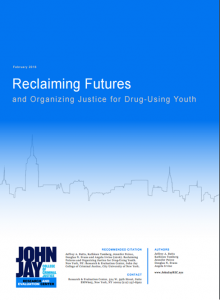Girls and Opioids: Vulnerabilities & Opportunities
By Reclaiming Futures, September 06 2017
In two separate blog posts in 2016, we discussed opioid use rates and substance use issues among adolescent girls involved with juvenile justice. In July 2017, the United States Department of Health and Human Services, Office on Women’s Health (OWH) released a report on opioid use, misuse, and overdose in women. The report provides information on the gender-specific issues and gaps in knowledge regarding females with substance use concerns/disorders. The report discusses the differences among females and males regarding the progression of substance use, the biological, social, and cultural issues (e.g., pain; relationships; family/parenting; trauma, determinants of health), effective treatments and barriers to implementation, and areas for further research. As it relates to adolescent girls (ages 12-17 years old), the report indicates they are more likely to use and become dependent on non-medical uses of prescription drugs as compared to adolescent boys. Access to prescription drugs can come from a home medicine cabinet and may help relieve mental health or physical pain symptoms and/or be part of their peer culture.Read more...






 Over the past decade, state and local jurisdictions have been actively developing strategies to reduce both recidivism and spending in their juvenile justice systems. Many also seek to ensure that every youth who comes in contact with the system is met with procedural fairness at every stage of the justice system. To help accomplish these goals, juvenile justice leaders are examining and applying research and recommendations outlined in Reforming Juvenile Justice: A Developmental Approach, a seminal report released by National Research Council in 2012. This report provides an extensive review of decades of research on juvenile justice programs and practices.
Over the past decade, state and local jurisdictions have been actively developing strategies to reduce both recidivism and spending in their juvenile justice systems. Many also seek to ensure that every youth who comes in contact with the system is met with procedural fairness at every stage of the justice system. To help accomplish these goals, juvenile justice leaders are examining and applying research and recommendations outlined in Reforming Juvenile Justice: A Developmental Approach, a seminal report released by National Research Council in 2012. This report provides an extensive review of decades of research on juvenile justice programs and practices. Young people in the juvenile justice system who have an overall positive experience are 49 percent less likely to continue committing crimes, according to arrest and/or return-to-placement reports.
Young people in the juvenile justice system who have an overall positive experience are 49 percent less likely to continue committing crimes, according to arrest and/or return-to-placement reports.
 Juvenile Justice Reform
Juvenile Justice Reform The Vera Institute of Justice
The Vera Institute of Justice  The Sentencing Project
The Sentencing Project The University of Massachusetts Medical School’s
The University of Massachusetts Medical School’s  This Fall, the Adler School
This Fall, the Adler School  A recent report from the
A recent report from the  Did you miss some of our blog posts last month? Not to worry - here's a round-up of our most popular posts from October 2012.
Did you miss some of our blog posts last month? Not to worry - here's a round-up of our most popular posts from October 2012. Minnesota’s
Minnesota’s